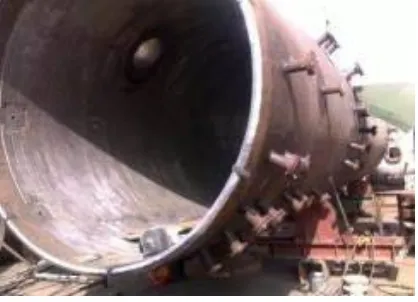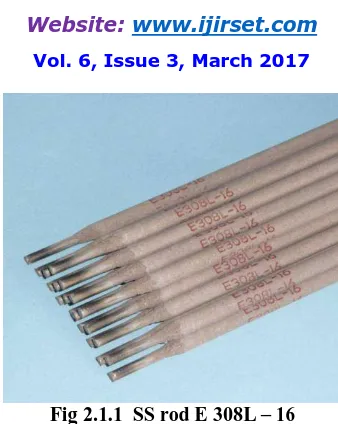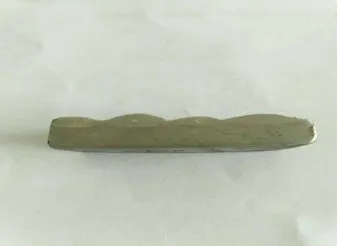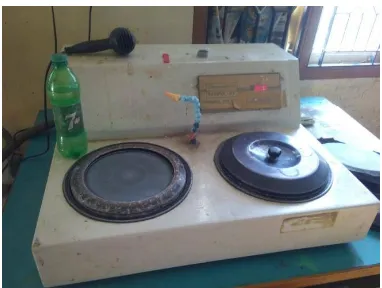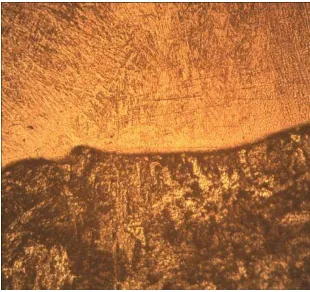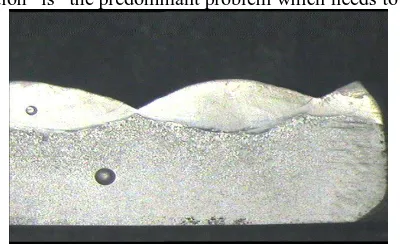Experimental Investigation of Process
Parameters of Stainless Steel Cladding on
Mild Steel Plate
1S.THIYAGARAJAN, 2N.LALITHKUMAR,3S.JEYAKUMAR
Dept. of Mechanical Engineering, Jay Shriram Group of Institutions, Tiruppur, Tamilnadu, India
ABSTRACT: The present study deals with cladding of stainless steel on mild steel. Cladding is a process of depositing a thick layer of filler material on a low carbon base metal. It finds application in repairing worn out parts for achieving good corrosion resistant surface. The process parameters have a direct influence on weld bead geometry which in turn has an impact on the properties of the metal. Stainless steel is found to have good corrosion resistance and depositing it on steel plate will ensure protection against corrosion. The project is carried out with the objective of studying the effect of process parameters on the weld quality and the properties. Welding current and welding speed are varied to find their effect on the properties of weld. Welding position is fixed. Experiments are conducted by varying the parameters. Microstructure and hardness values for different welding conditions are studied and the results are tabulated.
KEYWORDS: Cladding, Microstructure, Hardness
I. INTRODUCTION
Cladding is the application of one material over another to provide skin or layer intended to control the infiltration of weather elements, or for aesthetic purposes. Cladding does not necessarily have to provide a waterproof condition but is instead a control element. This control element may only serve to safely direct water or wind in order to control run-off and prevent infiltration into the building structure. This is also a control element to prevent noise from entering or escaping. Cladding applied to windows is often referred to as window capping and is a very specialized field.
II. STAINLESS STEEL CLADDING
ISSN(Online) : 2319-8753 ISSN (Print) : 2347-6710
I
nternational
J
ournal of
I
nnovative
R
esearch in
S
cience,
E
ngineering and
T
echnology
(An ISO 3297: 2007 Certified Organization)
Website: www.ijirset.com
Vol. 6, Issue 3, March 2017
Fig 2.1 Cladded Plate
Hot roll bonding is the general process used. In this process the clean plates of carbon steel and stainless steel are placed on each other, (single side cladding), or sandwiched between two stainless steel plates (double side cladding). The composite plates are hot rolled together. Stainless steel cladding process results bonding between the two metals. Another method of manufacturing includes explosive bonding. The bonding is produced by plastic deformation of metals because of intense collision during explosive bonding. Sometimes explosive bonding is followed by the hot rolling process to improve the bond between carbon steel and stainless steel. Clad carbon steel is used in the variety of applications such as chemical processes, oil refining, offshore oil production, etc. It is also used in power generation units, where there are high temperature and stress corrosion.
Fig 2.2 Stainless Steel Cladding
II.1. STAINLESS STEEL WELDING ROD
Fig 2.1.1 SS rod E 308L – 16
II.2. TYPICAL CHEMICAL COMPOSITION OF WELD METAL (%)
Carbon (C) - 0.024
Manganese (Mn) - 1.32
Silicon (Si) - 0.58
Phosphorus (P) - 0.030 Sulphur (S) - 0.009
Nickel (Ni) - 9.51
Chromium (Cr) - 19.94
II.3. TYPICAL MECHANICAL PROPERTIES OF WELD METAL
TS - 585 N/mm2
EL - 41%
In this project the Stainless steel cladding on mild steel is occurred by different weld speeds and current. There are 9 different types of specimens has been cladded. The following parameters has been occuerd for cladding.
The position of the welding is constant. The different Current is used
(100amp, 120amp, 80amp)
ISSN(Online) : 2319-8753 ISSN (Print) : 2347-6710
I
nternational
J
ournal of
I
nnovative
R
esearch in
S
cience,
E
ngineering and
T
echnology
(An ISO 3297: 2007 Certified Organization)
Website: www.ijirset.com
Vol. 6, Issue 3, March 2017
Specimen
Weld Time (s) Current (Amp)
1 40 120
2 40 100
3 40 80
4 60 120
5 60 100
6 60 80
7 20 120
8 20 100
9 20 80
Table 1.1 Specimen details
III. MILD STEEL PLATE
In this project the common Mild steel plate is been used for cladding process .The mild steel plate thickness is 5mm.And it has different chemical compositions.
Fig 5.1 Belt grinding machine
IV. STAINLESS STEEL’S APPLICATIONS AND BENEFITS
There are many reasons that stainless steel is a great choice, although of course ultimately it does depend on whether the material is suited to your application and your client’s budget, Here are some of the reasons why stainless steel cladding is becoming a more viable and popular choice amongst architects, designers.
V. POLISHING
ISSN(Online) : 2319-8753 ISSN (Print) : 2347-6710
I
nternational
J
ournal of
I
nnovative
R
esearch in
S
cience,
E
ngineering and
T
echnology
(An ISO 3297: 2007 Certified Organization)
Website: www.ijirset.com
Vol. 6, Issue 3, March 2017
VI. MICROSTRUCTURE OF THE SPECIMENS
Microstructure of cladded samples shows Austenitic grains + Acicular Ferritic microstructure in all the weld overlayed samples.
Sample 1 to 3 shows coarse grain microstructure in the weld cladded surface Sample 4 to 9 shows fine grain microstructure in the weld cladded surface For cladding is concern, it should resist corrosion.
Note: Microstructure having higher density of fine grains posse’s better resistance to pitting corrosion. Similarly, Microstructure having coarse grains posses lowers resistance to pitting corrosion.
Fig 6.1 Microstructure of the specimen
VII. MACROSTRUCTURE
Epitaxial mode of grain growth during solidification was observed all the weld cladded samples which show better metallurgical bond and integrity with substrate.
Cladding samples is free from defects such as crack, pores.
From sample no 1 to 9, the depth of penetration of weld bead is decreases. i.e. sample 1 has higher depth of penetration among all the samples.
Sample 9 posses least depth of penetration.
Note: If depth of penetration increases, dilution also increases because the formula for dilution is, So we can expect better cladding properties at sample
no 6, 7, 8 and 9.
Dilution is amount of base metal melted and participated in weld metal.
If the dilution % is less than 5 then there is chance of delamination to occur
So, we can expect better properties on cladded samples particularly whose dilution % value is less.
VIII. DILUTION
During weld overlaying, dilution is the predominant problem which needs to be addressed.
Fig 8.1 Macrostructure of the specimen
IX. HARDNESS
We are used Rockwell method to find the hardness. We are using B scale in the Rockwell hardness machine. The nine specimens have different hardness in stainless steel weld area. And the ball intender has been used in this method. In this method 100kg load is applied.
IX.1. ROCKWELL HARDNESS METHOD
ISSN(Online) : 2319-8753 ISSN (Print) : 2347-6710
I
nternational
J
ournal of
I
nnovative
R
esearch in
S
cience,
E
ngineering and
T
echnology
(An ISO 3297: 2007 Certified Organization)
Website: www.ijirset.com
Vol. 6, Issue 3, March 2017
X. CONCLUSION
The Stainless steel cladding on mild steel has been explained. The effect of process parameters on the weld quality and the properties. And the Microstructure and hardness values for different welding conditions are studied.
REFERENCES
1. Sreeraj, P. Kannan , T. Subhasis Maji, July 2013 ‘Prediction and optimization of stainless steel cladding deposited by GMAW process using response surface methodology, ANN and PSO’, International Journal Of Engineering And Science Vol.3, Issue 5 PP 30-41.
2. S.Missori, F.Murdolo, A.Sili., ‘MicroStructural Characterization Of a Stainless –Cladded on Carbon Steel’, Metallurgical Science and Technology-24.
3. Liane Smith., (October 2012) ‘Engineering with Clad Steel’, Nickel Institute Technical Series No.10 064. 4. P.Sreeraj, T.Kannan, Subhasis Maji., 2013
‘Optimization of weld bead geometry for stainless steel cladding deposited by GMAW’, American Journal of Engineering Research (AJER) e-ISSN : 2320-0847 p- e-ISSN : 2320-09 Volume-02, Issue-05, pp-
178-187.
5. Zina Dhib, NoamenGuermazi, MoniqueGaspérini, Nader Haddar., ‘Cladding of low-carbon steel to austenitic
stainless steel by hot-roll bonding: Microstructure and mechanical properties before and after welding (2016)’, Materials Science&EngineeringA656(2016)130–141.
6. Guangming Xie, Zongan Luo, Guanglei Wang, Liang Li and Guodong Wang., 2011
‘Interface Characteristic and Properties of Stainless Steel/HSLA Steel Clad Plate by Vacuum Rolling Cladding’, Materials Transactions, Vol. 52, No. 8 (2011) pp. 1709 to 1712 The Japan Institute of Metals.
7. Rakesh Kumar, Satish Kumar., ‘Study of Mechanical Properties in Mild Steel Using MIG welding’, IJRET: International Journal of Research in Engineering and Technology eISSN: 2319-1163 | pISSN: 2321-7308.
